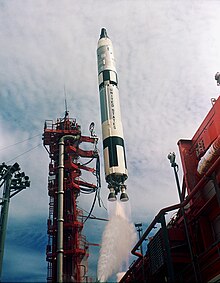
Back Titan 2 GLV Czech تیتان دو جی ال وی Persian Titan II GLV French Titan II GLV Galician טיטן 2 GLV HE Titan II GLV ID タイタンII GLV Japanese 타이탄 II GLV Korean Titan II GLV Malay Titan II Gemini LV Polish
This article needs additional citations for verification. (September 2020) |
 Launch of Gemini 11 on a Titan II GLV from LC-19 | |
| Function | Human-rated launch vehicle for Gemini spacecraft |
|---|---|
| Manufacturer | Martin |
| Country of origin | United States |
| Size | |
| Height | 109 ft (33 m)[1] |
| Diameter | 10 ft (3.0 m) |
| Mass | 340,000 lb (150 t) |
| Stages | 2 |
| Capacity | |
| Payload to LEO[altitude and inclination needed] | |
| Mass | 7,900 lb (3.6 t) |
| Associated rockets | |
| Family | Titan |
| Launch history | |
| Status | Retired |
| Launch sites | Cape Canaveral, LC-19 |
| Total launches | 12 |
| Success(es) | 12 |
| First flight | April 8, 1964 |
| Last flight | November 11, 1966 |
| Type of passengers/cargo | Gemini |
| First stage | |
| Powered by | 1 × LR87-AJ-7 |
| Maximum thrust | 1,900 kN (430,000 lbf) |
| Specific impulse | 258 s (2.53 km/s) |
| Burn time | 156 seconds |
| Propellant | Aerozine 50 / N2O4 |
| Second stage | |
| Powered by | 1 × LR91-AJ-7 |
| Maximum thrust | 440 kN (100,000 lbf) |
| Specific impulse | 316 s (3.10 km/s) |
| Burn time | 180 seconds |
| Propellant | Aerozine 50 / N2O4 |
The Titan II GLV (Gemini Launch Vehicle) or Gemini-Titan II was an American expendable launch system derived from the Titan II missile, which was used to launch twelve Gemini missions for NASA between 1964 and 1966. Two uncrewed launches followed by ten crewed ones were conducted from Launch Complex 19 at the Cape Canaveral Air Force Station, starting with Gemini 1 on April 8, 1964.
The Titan II was a two-stage liquid-fuel rocket, using a hypergolic propellant combination of Aerozine 50 fuel and nitrogen tetroxide oxidizer. The first stage was powered by an LR87 engine (with two combustion chambers and nozzles, fed by separate sets of turbomachinery),[2][3] and the second stage was propelled by an LR91 engine.
- ^ Gatland, Kenneth (1976), Manned Spacecraft (2nd revision ed.), New York: MacMillan, p. 37, ISBN 0-02-542820-9
- ^ Sutton, George P. (2006). History of liquid propellant rocket engines. Reston, Va.: American Institute of Aeronautics and Astronautics. pp. 381, 384. ISBN 1-56347-649-5. OCLC 63680957.
- ^ "Aerojet-General LR87 Liquid Rocket". National Museum of the US Air Force. Archived from the original on December 25, 2010. Retrieved December 25, 2010.